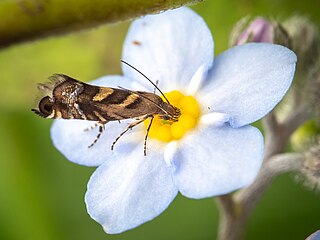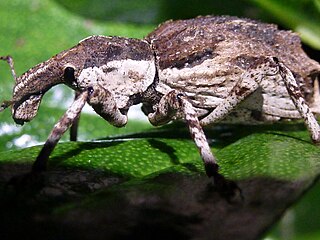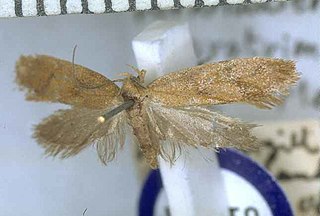
Weevils are beetles belonging to the superfamily Curculionoidea, known for their elongated snouts. They are usually small – less than 6 mm in length – and herbivorous. Approximately 97,000 species of weevils are known. They belong to several families, with most of them in the family Curculionidae. It also includes bark beetles, which while morphologically dissimilar to other weevils in lacking the distinctive snout, is a subfamily of Curculionidae. Some other beetles, although not closely related, bear the name "weevil", such as the biscuit weevil, which belongs to the family Ptinidae.

Pericoptus truncatus is a large sand scarab beetle. It is native to New Zealand and is found on beaches throughout New Zealand. Its Māori name is ngungutawa.

Glyphipterix tungella is a species of sedge moth in the genus Glyphipterix. It is endemic to New Zealand and is found throughout the country. Larvae mine the leaves of small sedges. Adults of this species are day flying and inhabit sheltered scrub or grassy areas and forest clearings.

Anagotus stephenensis, commonly known as the ngaio weevil, is a large flightless weevil that is only found on Stephens Island in New Zealand. The ngaio weevil was discovered in 1916 by A.C. O'Connor on Stephens Island. Thomas Broun described it in 1921 as Phaeophanus oconnori after its collector. The weevils were observed at the time to be 'feeding on tall fescue and the leaves of trees'.

Eucallipterus tiliae, also known as the linden aphid or lime-tree aphid, is a member of the family Aphididae. Native to Eurasia in recent times, it is now found worldwide wherever species of Tilia occur.

Pseudorupilia ruficollis aka as the Swollen Restio Beetle is a member of the Chrysomelidae family. Pseudorupilia resembles the Australian genus Rupilia whence its generic name. It is known only from South Africa and is strongly associated with the Cape fynbos, feeding on the pollen of Restionaceae, Proteaceae and Asteraceae.

Helophilus fasciatus, the narrow-headed marsh fly, is an abundant species of syrphid fly observed throughout the United States and Canada. Hoverflies can remain nearly motionless in flight. The adults are also known as flower flies for they are commonly found on flowers, from which they get both energy-giving nectar and protein-rich pollen. The larvae of this genus are associated with wet decaying organic material, particularly accumulations of decaying vegetation in ponds and mud and farmyard manure or silage. The adults of this species lays eggs on vegetation overhanging the water. The larvae hatch and drop into the water.

Blera pictipes, the painted wood fly, is a rare species of syrphid fly first officially described by Bigot in 1883. Hoverflies get their names from the ability to remain nearly motionless while in flight. The adults are also known as flower flies for they are commonly found around and on flowers, from which they get both energy-giving nectar and protein-rich pollen. The larvae are of the rat-tailed type, feeding on exuding sap or in the rot holes of trees.

Blera robusta, the greenish wood fly, is a rare species of syrphid fly first officially described by Curran in 1922. Hoverflies get this name from the ability to remain nearly motionless while in flight. The adults are also known as flower flies, for they are commonly found around and on the flowers from which they get both energy-giving nectar and protein rich pollen. The larvae are of the rat-tailed type, feeding on exuding sap or in the rot holes of trees.

Helophilus obscurus , the obscure marsh fly, is a common species of syrphid fly observed throughout Canada and the northern United States and Rocky Mountains. Hoverflies can remain nearly motionless in flight. The adults are also known as flower flies for they are commonly found on flowers, from which they get both energy-giving nectar and protein-rich pollen. The larvae of this genus are associated with wet decaying organic material, particularly accumulations of decaying vegetation in ponds and mud and farmyard manure or silage the larvae of this species are not known.

Hoherius meinertzhageni, the ribbonwood fungus weevil, is an endemic New Zealand beetle that has been recorded feeding on the ribbonwood species Plagianthus regius and Plagianthus divaricatus and the mountain lacebark, Hoheria glabrata.
Pentoxydema rostralis, is a species of weevil found in Sri Lanka.
Horniolus dispar, is a species of lady beetle found in Sri Lanka.
Jauravia pallidula, is a species of lady beetle native to India, and Sri Lanka.
Eutassa fuscicollis is a beetle in the Curculionidae family. It was first described by Thomas Broun in 1909, and is endemic to New Zealand

Tingena paratrimma is a species of moth in the family Oecophoridae. It is endemic to New Zealand and has been observed in the lower parts of the South Island. George Hudson regarded this species are uncommon. The adults of this species are on the wing from November to February.

Trachypepla aspidephora is a species of moth in the family Oecophoridae. It is endemic to New Zealand and has been observed in the North and South Islands. Adults are on the wing from November to March and are attracted to light. The moths can be found resting on tree trunks where their colouration imitates lichens.
Microdon ocellaris, the hairy-legged ant fly, is a rare species of syrphid fly observed in the eastern United States. Hoverflies can remain nearly motionless in flight. The adults are also known as flower flies for they are commonly found on flowers, from which they get both energy-giving nectar and protein-rich pollen. The larvae have been found in the nests of Formica pallidefulva.

Prodontria longitarsis is a species of flightless beetle in the family Scarabaeidae. This species was first described by Broun in 1909 as Odontria longitarsis. The holotype specimen was collected by George Hudson during the Sub-Antarctic Islands Scientific Expedition and is held at Te Papa.
Alloecentrella magnicornis is a species of caddisfly belonging to the order Trichoptera. The species was first described by Keith Arthur John Wise in 1958, and is endemic to New Zealand.
















